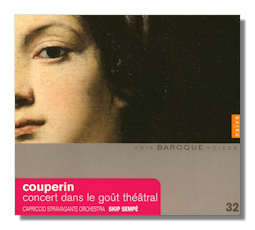
The Internet's Premier Classical Music Source
Related Links
- F. Couperin Reviews
- Latest Reviews
- More Reviews
-
By Composer
-
Collections
DVD & Blu-ray
Books
Concert Reviews
Articles/Interviews
Software
Audio
Search Amazon
Recommended Links
Site News
 CD Review
CD Review
François Couperin

Concert dans le goût théâtral
- Nouveaux concerts #8 in G Major "dans le goût théatral"
- Qu'on ne me dise plus
- Zéphire
- Doux liens de mon coeur
- Jean s'en alla "Epitaphe d'un paresseux"
- La femme entre deux draps
- A moy! Tout est perdu!
- Dans l'isle de Cythère "Les solitaires"
- Il faut aimer des qu'on scait plaire "La pastorelle"
- Au temple de l'amour
- Trois vestales champÍtres et trois Poliçons
- Faisons du temps un doux usage "Vaudeville"
- A l'ombre d'un ormeau
Capriccio Stravagante Orchestra/Skip Sempé
Naîve E8929
A better understanding of the greatness of François Couperin (1668-1733) comes in part from appreciating that he wrote in many more genres than that of the solo harpsichord – especially the four books of Pièces de Clavecin. His religious music is somewhat better known. But his music for theater hardly at all. Now here is a collection of two dozen or so numbers, the Concert dans le goût théâtral, which formed the eighth concert of Les Goûts Réunis as performed at Versailles during the last quarter of the seventeenth century. Inevitably, there has had to be much speculation in reconstructing and situating this music. The division between chamber and orchestral music in Couperin's time was less clear than it later became. The interleaving and specific use of parts and wholes for certain occasions, then their re-use for others, rearrangements and repurposing of subsets, sets and supersets of compositional ideas were all too common for definitive performances necessarily to reproduce exactly what French, Parisian and particularly audiences at Versailles would have heard.
This hour's worth of music from soloists, Capriccio Stravagante under Skip Sempé, nevertheless, provides fertile soil in which Couperin's reputation as an impressive exponent of exciting and engaging theatrical music can grow. The standard of playing and singing is very high. Sempé's playing is always a delight… mellow, yet full of punch; clean yet always on its toes: listen to his Mouvement de Passacaille solo [tr.23], for example. A world in six minutes. The extent to which the ensemble plays as an ensemble and plays so well in tune with the idioms ensures that this CD is a success. They bring out the life of every bar of the music. Five of the Divertissements are available on a collection, "Les musiques de Louis XIV Vol 2" (naîve 5197). So this is the first full performance, the aforementioned caveats about reconstruction notwithstanding.
There are moments, indeed, when the dramatic qualities of the music and the text on which it is based are very evident: the third number of the Amours badins, La femme entre deux draps [tr.13], for example, really does generate excitement. But given its racy subject-matter, this is as it should be. There us also great and telling contrast in the playing and singing: throughout the variations in "Les Plaisirs de l'Ile enchantée" [tr.s 22-25], for instance there is gentleness, hurry, force, humility, grace and enthusiasm. But all are achieved with the greatest of style.
Tempi throughout this performance are uniformly tight and expressive. Of course the influence of Lullian dotted crotchets is heavily felt. But that was the prevailing style. Couperin (said he) admired Lully too much not to pay him constant homage and reflect what his directness and focus communicated to audiences. But the music is always Couperin's. By the time you reach the Retour at the end with its tender, lilting confidence, you realize just how well Couperin wrote for the theater. And wish for more. That's a worthy achievement by these musicians.
The acoustic is closer than one might imagine for a theatrical atmosphere but works well, projecting our attention onto the music and the text at all times. The booklet which comes with the CD is full of useful information and full texts in French, German and English; the font size, though, is too small throughout to read comfortably. These minor quibbles notwithstanding, this is a gem of a CD and well worth looking into for reasons well beyond those of extending our understanding of Couperin.
Copyright © 2010, Mark Sealey.





















